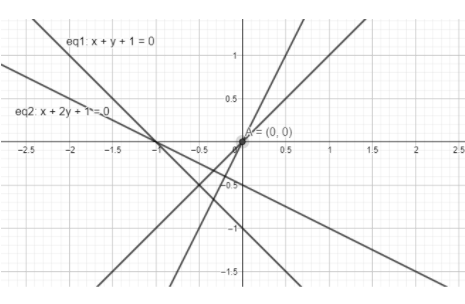Question
Question: In \(x+y+1=0\) and \(x+2y+1=0\) are angle bisector of lines \({{L}_{1}}\) and \({{L}_{2}}\) and poin...
In x+y+1=0 and x+2y+1=0 are angle bisector of lines L1 and L2 and point (0,0) lies on L1 , then acute angle bisector of L1 and L2 is,
(a) x+y−1=0
(b) x+y+1=0
(c) x+2y+1=0
(d) Data insufficient
Solution
First find the points A, B, C by intersection of sides given in the question. So given an internal angular bisector, the bisector bisects the angle into 2 equal halves hence, it divides the side opposite into 2 parts with ratio of corresponding sides. Equation of angular bisector of two equation of line ax+by+c=0,dx+ey+f=0 is given by
a2+b2ax+by+c=±d2+e2dx+ey+f
These 2 lines become the equations of bisectors.
Complete step-by-step answer :
If two lines from an angle then they have 2 angles bisectors because between 2 lines there are 2 angles possible which are acute and obtuse. So, the 2 lines bisecting these 2 angles between lines ax+by+c=0,dx+ey+f=0 are given by
a2+b2ax+by+c=±d2+e2dx+ey+f
So, the symbol plus or minus denotes 2 equations of bisectors. Out of both any of them may be acute and may be obtuse if one is acute the other is obtuse and vice versa.
The both given bisectors are x+y+1=0 , x+2y+1=0 , we need to find out the acute angle bisector from these both.

In the figure we are representing 2 lines and perpendiculars from A. The reason we plotted perpendiculars will be understood in the following solution.
As given (0,0) lies on L1 . we will find the perpendicular distance of (0,0) to both the lines.
Perpendicular distance of a line ax+by+c=0 from (h,k) :
Let the distance be represented by d (for temporary)
d=a2+b2ah+bk+c
Perpendicular distance of the line x+y+1=0 from (0,0) .
Let the distance be represented by a.
a=12+120+0+1=21
By simplifying we get the value of a to be 21. Perpendicular distance of the line x+2y+1=0 from (0,0) .
Let the distance be represented by b.
b=12+220+0+1=51
By simplifying we get b to be 51 .
We have a < b . So, the sin of angle made will be greater in case of a. So, it will be obtuse. The line x+2y+1=0 will be acute. Option (c) is correct.
Note :Be careful while relating the distance to angle. Here, it is opposite/hypotenuse. Since the value of sine of angle is directly proportional to distance. Use the above relation properly as the sine of angle we get will be perpendicular from A / hypotenuse. As hypotenuse is the same we can relate directly to the perpendicular distance.
